Li S.Z., Jain A.K. (eds.) Encyclopedia of Biometrics
Подождите немного. Документ загружается.


Fingerprint Reading
▶ Biometric Sample Acquisition
Fingerprint Recognition, Overview
DAV I DE MALTONI
DEIS, University of Bologna, Italy
Synonym
Fingerprint Biometric
Definition
Fingerprint recognition allows a person to be verified
or identified through the analysis and comparison of
his or her finger dermal ridges. Fingerprint recognition
was one of the first techniques used for automatically
identifying people and today is still one of the most
popular and effective biometric techniques.
Introduction
A fingerprint is the representation of the dermal ridges
of a finger [1]. Dermal ridges form through a combi-
nation of genetic and environmental factors; the genet-
ic code in DNA gives general instructions on the way
skin should form in a developing fetus, but the specific
way it forms is a result of random events such as the
exact position of the fetus in the womb at a particular
moment. This is the reason why even the fingerprints
of identical twins are different [2]. Fingerprints are fully
formed at about 7 months of fetus development and
finger ridge configurations do not change throughout
the life of an individual, except in case of accidents such
as severe cuts on the fingertips. This stability makes
fingerprints a very attractive biometric identifier. Several
mathematical models based on the
▶ anatomy of fric-
tion ridge skin were developed over the years to quan-
tify
▶ fingerprint individuality [3] and to prove that
finding two persons with identical fingerprints is ex-
tremely unlikely. This does not imply that fingerprint
recognition is a perfect technique: in fact, various
kinds of errors can affect fingerprint acquisition and
processing thus requiring to introduce thresholds to
decide if two fingerprint impressions are similar
enough to be considered belonging to the same person.
As for any biometric technique, a sound performance
evaluation (see
▶ fingerprint databa ses and evalua-
tion) is extremely important to estimate the accuracy
of a fingerprint-based biometric system and to under-
stand if it is well-suited for a particular application.
Recent independent evaluation campaigns such as
FVC2006 [4] proved that state-of-the art fingerprint
recognition algorithms are nowadays ver y accurate
(i.e., EER less than 0.1% for a database collected with
a large area optical scanner).
History
Human fingerprints have been discovered on archaeo-
logical artefacts and historical items (Fig. 1). Although
these findings prove that ancient people used finger-
prints for a number of purposes, it was not until the
late sixteenth century that the modern scientific finger-
print studies were initiated [5]. In 1686, Marcello
Malpighi, a professor of anatomy at the University of
Bologna, noted the presence of ridges, spirals and
loops in fingerprints. Henry Fauld, in 1880, was the
first to scientifically suggest the individuality of finger-
prints based on an empirical observation. At the same
time, Herschel asserted that he had practiced finger-
print recognition for about 20 years. In the late nine-
teenth century, Sir Francis Galton conducted an
extensive study on fingerprints; in 1888 he introduced
the
▶ minutiae features for fingerprint matching. An-
other important advance was made in 1899 by Edward
Henry, who established the well-kn own ‘‘Henry sys-
tem’’ of
▶ fingerprint classification.
In the early twentieth century, fingerprint recogni-
tion was formally accepted as a valid identification
method and became a standard routine in forensics
[5]. Fingerprint identification agencies were set up
worldwide and criminal fingerprint databases were
established; for instance, the FBI fingerprint identifica-
tion division was set up, in 1924, with a database of
810,000 fingerprint cards. With the rapid expansion
of fingerprint recognition in forensics, operational
510
F
Fingerprint Reading
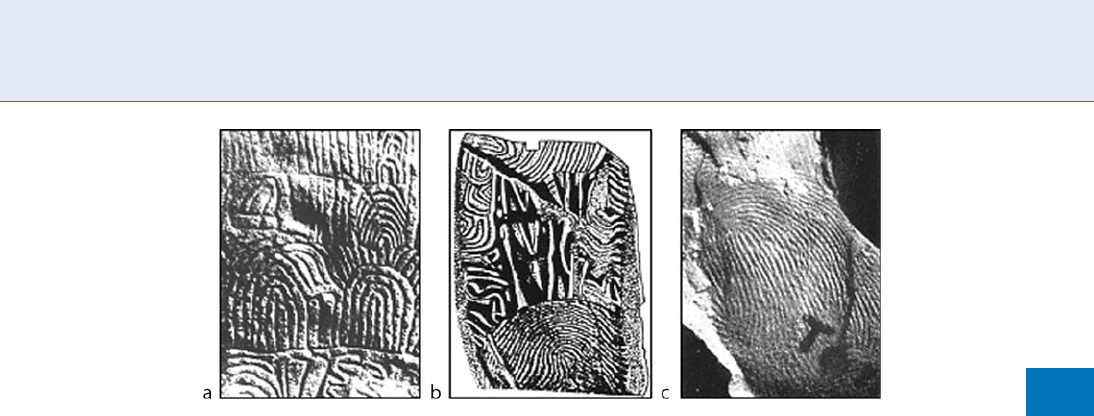
fingerprint databases grew so large that manual finger-
print identificat ion (see
▶ fingerprint matching, man-
ual) became infeasible; for example, the total number
of fingerprint cards in the FBI fingerprint database
stands well over 200 million and is continuously grow-
ing. With thousands of requests being received daily,
even a team of more than 1300 fingerprint experts were
not able to provide timely responses to these requests.
Starting in the early 1960s, the FBI, Home Office in the
UK, and Paris Police Depar tment began to invest
a large amount of effort in developing Automati c
Fingerprint Identification Systems (
▶ AFIS). Based on
the observations of how human fingerprint experts per-
form fingerprint recognition, three major problems in
designing AFIS were identified and investigated: digital
fingerprint acquisition, local ridge feature extraction,
and ridge characteristic pattern matching. Their efforts
were so successful that today almost every law enforce-
ment agency worldwide uses an AFIS. These systems
have greatly improved the operational productivity of
law enforcement agencies and reduced the cost of hiring
and training human fingerprint experts.
Automatic fingerprint recognition technology
has now rapidly grown beyond forensic applications.
On the one side, together with face, fingerprint is the
main biometric modality for electronic documents
(e-passport, visas, ID cards, etc) used to enforce border
crossing and citizen security. On the other side, thanks
to a ver y good performance/cost tradeoff, fingerprint-
based biometric systems are becoming very popular
and are being deployed in a wide range of commercial
applications such as logon to computers and networks,
physical access control, ATMs.
Components of a Fingerprint
Recognition System
The block diagram of a fingerprint-based recognition
system is depicted in Fig. 2.
A fingerprint is acquired through a live-scan
▶ fin-
gerprint device that allows to simply and quickly cap-
ture a digital fingerprint image: most of the fingerprint
devices sample the pattern at 500 DPI (Dots per Inch)
and produce an 8-bit gray-scale raw image (see Fig. 3).
Some devices also include fake detection mechanisms
(see
▶ fingerprint fake detection) that allow to reveal
spoofing attacks carried out with fake fingers.
The acquired raw image is then passed to a quality
control module that evaluates if the fingerprint sample
quality is good enough to correctly process it and to
extract reliable features. In case of insufficient quality,
the system rejects the sample and invites the user to
repeat the acquisition; otherwise, the raw image is passed
to an
▶ image enhancement module whose goal is
improving the clarity of the ridge pattern, especially in
noisy region, to simplify the subsequent feature extrac-
tion. Special digital filtering techniques, known as con-
textual filtering [1], are usually adopted at this stage; the
output enhanced image can still be a gray-scale image or
become a black-and-white image. The
▶ feature extrac-
tion module further processes the enhanced image and
extracts a set of features from it. This feature set often
includes minutiae but, depending on the matching algo-
rithm, other features (e.g., local orientation, local fre-
quency,singularities,ridgeshapes,ridgecounts,partsof
the enhanc ed image, etc.) can be extracted in conjunc-
tion with (or instead of) minutiae.
Fingerprint Recognition, Overview. Figure 1 Examples of archaeological fingerprint carvings and historic fingerprint
impressions: (a) Neolithic carvings (Gavrinis Island); (b) standing stone (Goat Island, 2000 B.C.); (c) an impression on a
Palestinian lamp (400 A.D.). Figures courtesy of A. Moenssens and R. Gaensslen.
Fingerprint Recognition, Overview
F
511
F
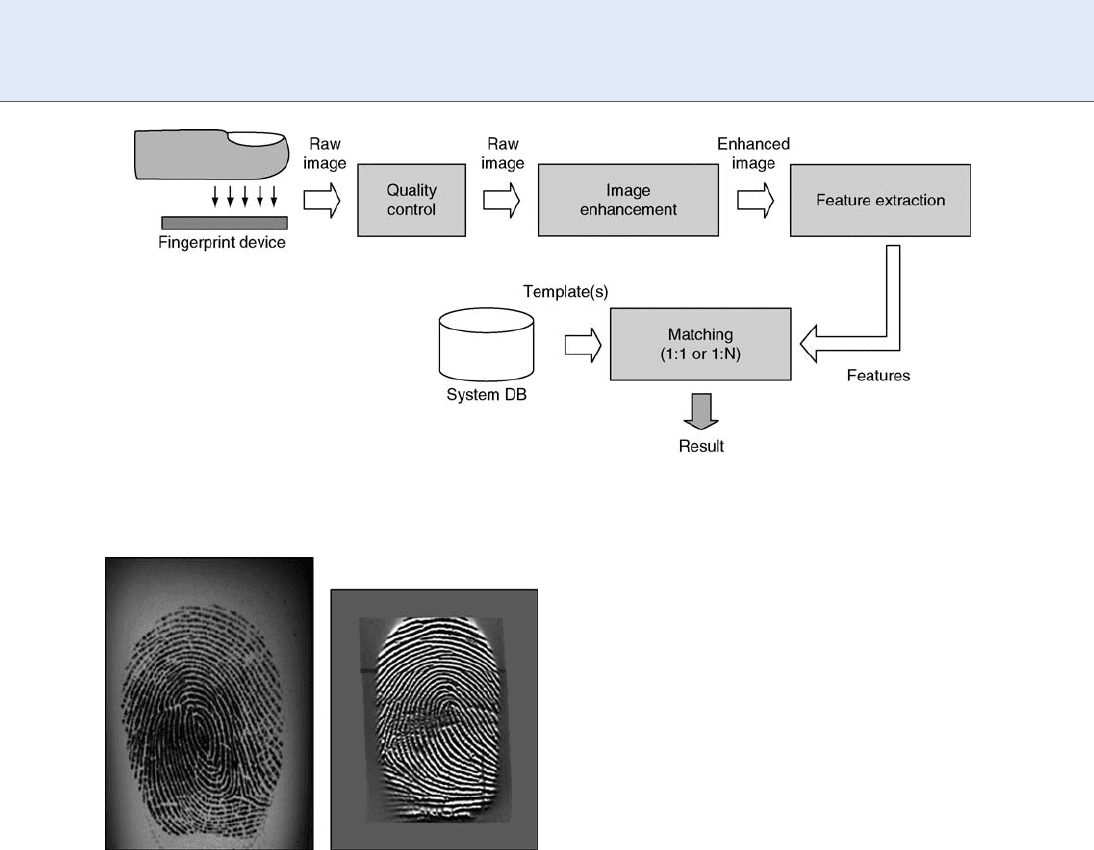
Finally, the fingerprint matching module (see ▶ fin-
gerprint matching, automatic) retrieves from a system
database one or more templates (see
▶ fingerprint
templates) and matches it/them with the features
extracted from the current sample. Most of the match-
ing algorithms, following the well established manual
method (see
▶ fingerprint matching, manual), com-
pare two fingerprints by searching the spatial correspon-
dence of a minimum number of minutiae; this is not a
simple task because of the large variations (e.g., dis-
placement, rotation, skin condition, distortion, noise,
etc.) that can characterize two fingerprint images ac-
quired from the same finger at different times. If the
systems is operating in verification mode, the user has
been required to claim his identity and therefore just
one template is retrieved from the database and
matched with the current sample; if the system is
operating in identification mode the current sample is
matched against all the database templates to check is
one of them is sufficiently similar.
Protecting fingerprint templates is very important
to avoid attacks to fingerprint-based biometric systems
[6] and to preserve user privacy: cryptography techni-
ques can be used to this purpose (see
▶ Fingerprints
Hashing).
Large-Scale Automatic Fingerprint
Identification Systems
Large-scale automatic fingerprint identification sys-
tems (AFIS) are used in forensic and civil government
applications. The basic functioning of these systems
is the same as described in the previous section, but
a number of ad-hoc optimizations are employed to
effectively and efficiently store, retrieve and match
millions of fingerprints in a few seconds. In the past,
special dedicated hardware and stor age devices were
used to guarantee the required throughput; nowadays,
most of the AFIS cores run on conventional hardware
(e.g., cluster of personal computers) and the software is
the main responsible of the system efficiency. Finger-
print classification and
▶ fingerprint indexing are the
two main techniques used to speed-up a fingerprint
search in a large database [1]. The former allows to split
the database in a number of partitions and to limit the
search to the partition to which the searched sample
belongs to. The latter enables sorting the database tem-
plates according to the similarity with the searched
Fingerprint Recognition, Overview. Figure 2 Block diagram of a fingerprint-based recognition system.
Fingerprint Recognition, Overview. Figure 3 Example of
fingerprint images from FVC2006 databases [4].
512
F
Fingerprint Recognition, Overview

sample, so that the probability to find a mate in the first
attempts increases significantly. Even if the capacity of
mass storage devices is continuously growing, storing
fingerprints as uncompressed raw images would require
too much space (nowadays AFIS must store billions of
fingerprint images) and would increase the time neces-
sary to transmit a fingerprint record over a network; to
alleviate this problem, without compromising recogni-
tion accuracy, specific
▶ fingerprint compression tech-
niques such as WSQ (Wavelet Scalar Quantization)
have been developed by researchers.
Related Entries
▶ Biometrics, Overview
▶ Biometric Recognition
▶ Fingerprint Anatomy
▶ Fingerprint Classification
▶ Fingerprint Compression
▶ Fingerprint Databases and Evaluation
▶ Fingerprint Fake detection
▶ Fingerprint Features
▶ Fingerprint Image Enhancement
▶ Fingerprint Indexing
▶ Fingerprint Individuality
▶ Fingerprint Matching, Automatic
▶ Fingerprint Matching, Manual
▶ Fingerprint Image Quality
▶ Fingerprint Templates
▶ Fingerprints Hashing
References
1. Maltoni, D., Maio, D., Jain, A.K., Prabhakar, S.: Handbook of
fingerprint recognition. Springer, New York (2003)
2. Jain, A.K., Prabhakar, S., Pankanti, S.: On the similarity
of identical twin fingerprints. Pattern Recognit. 35(11),
2653–2663 (2002)
3. Pankanti, S., Prabhakar, S., Jain, A.K.: On the individuality of
fingerprints. IEEE Trans. Pattern Anal. Mach. Intell. 24(8),
1010–1025 (2002)
4. The Fourth International Fingerprint Verification Competition
(FVC2006) http://bias.csr.unibo.it/fvc2006.
5. Lee, H.C., Gaensslen, R.E.: Advances in fingerprint technology.
2nd Edn. Elsevier, New York (2001).
6. Cappelli, R., Lumini, A., Maio, D., Maltoni, D.: Fingerprint
image reconstruction from standard templates. IEEE Trans.
Pattern Anal. Mach. Intell. 29(9), 1489–1503 (2007)
Fingerprint Representation
▶ Fingerprint Templates
Fingerprint Retrieval
Fingerprint retrieval is a procedure that draws a subset
of fingerprints from a database stored on a computer
system based on some similarity measure between a
query fingerprint and the fingerprints in the database.
The ultimate goal of fingerprint retrieval is not to find
a group of fingerprints similar to the query fingerprint,
but to get back the fingerprint originating from the
same finger as that of the query fingerprint. Hence,
success or failure of the fingerprint retrieval is deter-
mined by whether the retrieved subset contains the
fingerprint originating from the same finger as that of
the query fingerprint.
▶ Fingerprint Classification
▶ Fingerprint Indexing
Fingerprint Sample Synthesis
RAFFAELE CAPPELLI
Biometric System Laboratory, DEIS, University of
Bologna, Cesena, Italy
Synonyms
Synthetic fingerprint generation; Synthetic finger-
prints; Artificial fingerprints
Definition
Fingerprint sample synthesis is the generation of
images similar to human fingerprints, through para-
metric models that simulate the main characteristics
of such biometric data and their modes of variation.
The image synthesis is typically performed by a
computer program that, starting from some input
Fingerprint Sample Synthesis
F
513
F

parameters, executes a sequence of algorithmic steps
that finally produce a synthetic fingerprint image.
Introduction
With the increasingly adoption of fingerprint recogni-
tion systems, driven by their very appealing accuracy/
cost tradeoff, methodical and accurate performance
evaluations of fingerprint recognition algorithms are
needed. Unfortunately, this requires large databases
of fingerprints, due to the very small rates of error
necessary for the procedure. For instance, according
to [1], in order to support a claim of FMR less than
1/10,000 (the requirement for verification applications
in [2]), 30,000 impostor matches from at least 250
individuals should be performed without observing
any false match error. On the other hand, collecting
large databases of fingerprint images is expensive both
in terms of money and time, boring for both the
people involved and for the volunteers, and problem-
atic due to the privacy legislation that protects such
personal data. FVC competitions [3] are examples of
technolog y evaluations, where real fingerprint data-
bases have been collected to test different algorithms,
but do not constitute lasting solutions for evaluating
and comparing different algorithms; in fact, since FVC
databases are made available to the participants after
the competition to let them improve the technology,
they expire once ‘‘used,’’ and new databases have to be
collected for future evaluations.
Fingerprint synthesis is a feasible way to address the
issues just cited, since it allows large databases of images
to be easily generated and used for testing fingerprint
recognition systems without infringing on privacy.
A fingerprint synthesis method typically consists of
two main steps: first, a ridge pattern, which represents
the unique and immutable characteristics of a ‘‘synthetic
finger,’’ is generated according to a given model; then,
one or more ‘‘fingerprints’’ of the synthetic finger are
generated by simulating the main factors that make the
fingerprints of a given human finger different each other.
Physical Ridge Pattern Models
Physical ridge pattern models are based on some
hypothesized physical mechanisms of fingerprint for-
mation during embryogenesis.
The crucial period of fingerprint development in
humans starts at the 10th week of pregnancy [4], when
the epidermis consists of three layers (outside layer,
intermediate layer and basal layer). It is then observed
that the basal layer of the epidermis becomes undulat-
ed toward the surface, forming the so-called ‘‘primary
ridges,’’ whose development ends at about the 17th
week of pregnancy: at this stage the geometry of the
epidermal ridge pattern is determined for life and
becomes visible on the skin surface in subsequent weeks.
Several theories for fingerprint pattern formation
have been proposed in the scientific literature [4],
including cell proliferation phenomena, mechanical
interaction between the extracellular matrix and fibro-
blasts in the dermis, reaction-diffusion models.
In a study by Sherstinsky and Picard [5], a complex
method which employs a dynamic non-linear system
called ‘‘M-lattice,’’ is introduced. The method is based
on the reaction-diffusion model first proposed by Tur-
ing in 1952 to explain the formation of animal patterns
such as zebra stripes. Although this work is aimed at
optimally binarizing a fingerprint image, the underly-
ing ridge-line model could be used as a basis for
synthetic generation.
An interesting model was proposed by Ku
¨
cken
[4, 6], based on the following hypotheses:
1. Fingerprint pattern s are created by forces that are
induced by differential growth of the epidermis’
basal layer (as argued by Cummins [7] from the
observed dependency of the pattern class on the
fingertip geometry)
2. Non-uniform growth of the epidermis’ basal layer
results in compressive stress that leads to bu ckling,
creating the primary-ridges [8]
Ku
¨
cken considers the basal layer as an elastic sheet
trapped between the neighboring tissues of the inter-
mediate epidermis layer and the dermis (Fig. 1)
and studied the buckling process by means of the von
Karman equations, which descri be the behavior of a
thin curved sheet of elastic material. The analysis of
those equations confirmed that the direction of the
ridges is roughly perpendicular to the direction of
greatest stress; Ku
¨
cken postulated that two factors
mainly contribute to generate the compressive stress
in the basal layer: (1) resistance at the nail furrow and
at the major flexion creases of the finger (boundary
effects); (2) the regression of the ‘‘volar pads’’ at the
time of fingerprint development. Volar pads are
514
F
Fingerprint Sample Synthesis
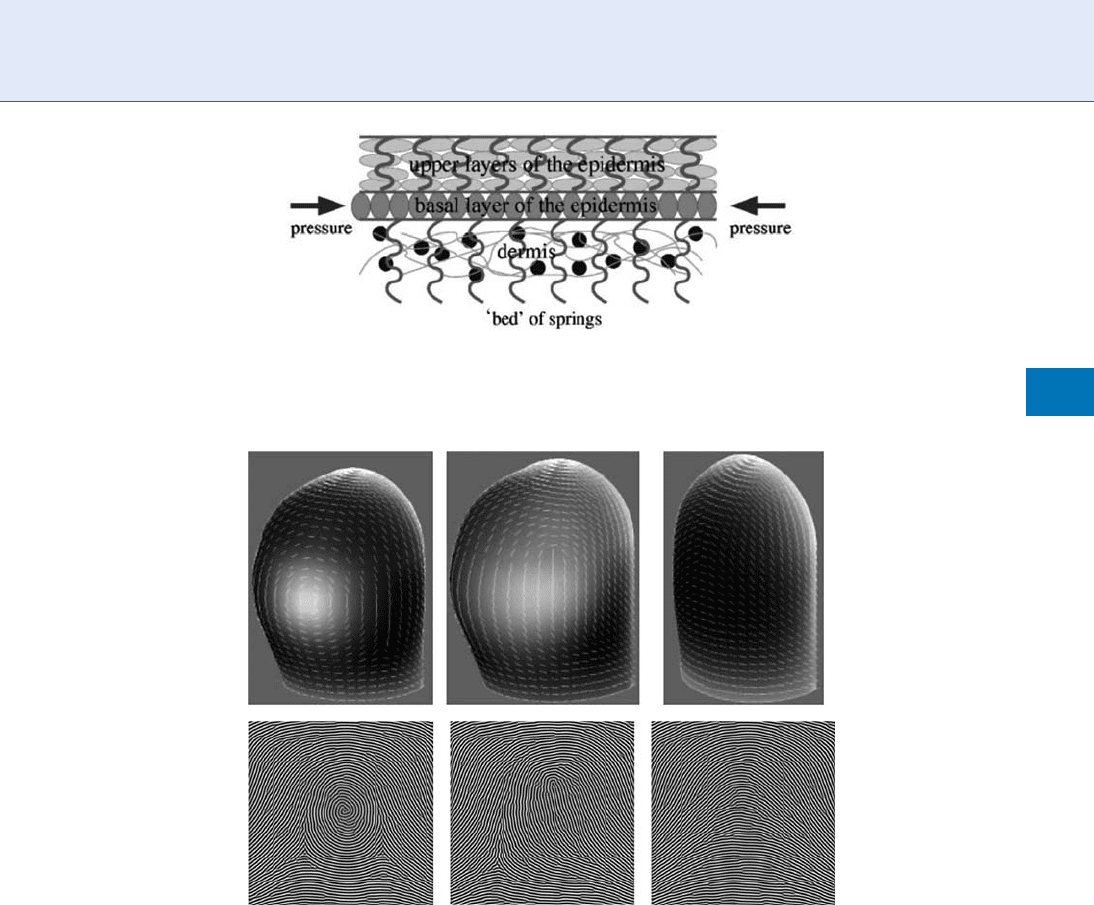
temporary eminences of the skin surface that form
during the 7th week of pregnancy and start to digress
at about the 10th week. From studies of embryos,
monkeys and malformed hands, it has consistently
been observed that highly rounded pads at the finger-
tips exhibit whorls; less well-developed pads show
loops, where the direction of the loop opening is de-
termined by the asymmetry of the pad; small indistinct
pads give rise to arches.
Computer simulations have shown results consis-
tent with the above observations and hypothesis; Fig. 2
shows how an almost periodic pattern very similar to
human fingerprints can be generated by applying
Ku
¨
cken’s model: the three main fingerprint classes
can be simulated and
▶ minutiae are present in regions
where ridge patches with different directions and/or
wavelength meet.
Statistical Ridge Pattern Models
Statistical ridge pattern models aims to reproduce
realistic-looking fingerprints without starting from
embryological hypothesis. Such models are based on
the empirical analysis of real fingerprints, from which
statistical data about the main characteristics of the
patterns are derived and parameterized into appro-
priate equations or synthesis algorithms.
In 1999, Kosz published some interesting
results concerning fingerprint synthesis based on a
Fingerprint Sample Synthesis. Figure 1 The basal layer of epidermis: Ku
¨
cken and Newell [6] assumes that due to
differential growth, a compressive stress act on this layer.
Fingerprint Sample Synthesis. Figure 2 Simulation of three common fingerprint patters (from left to right: whorl, loop,
and arch) using the model proposed in [6].
Fingerprint Sample Synthesis
F
515
F
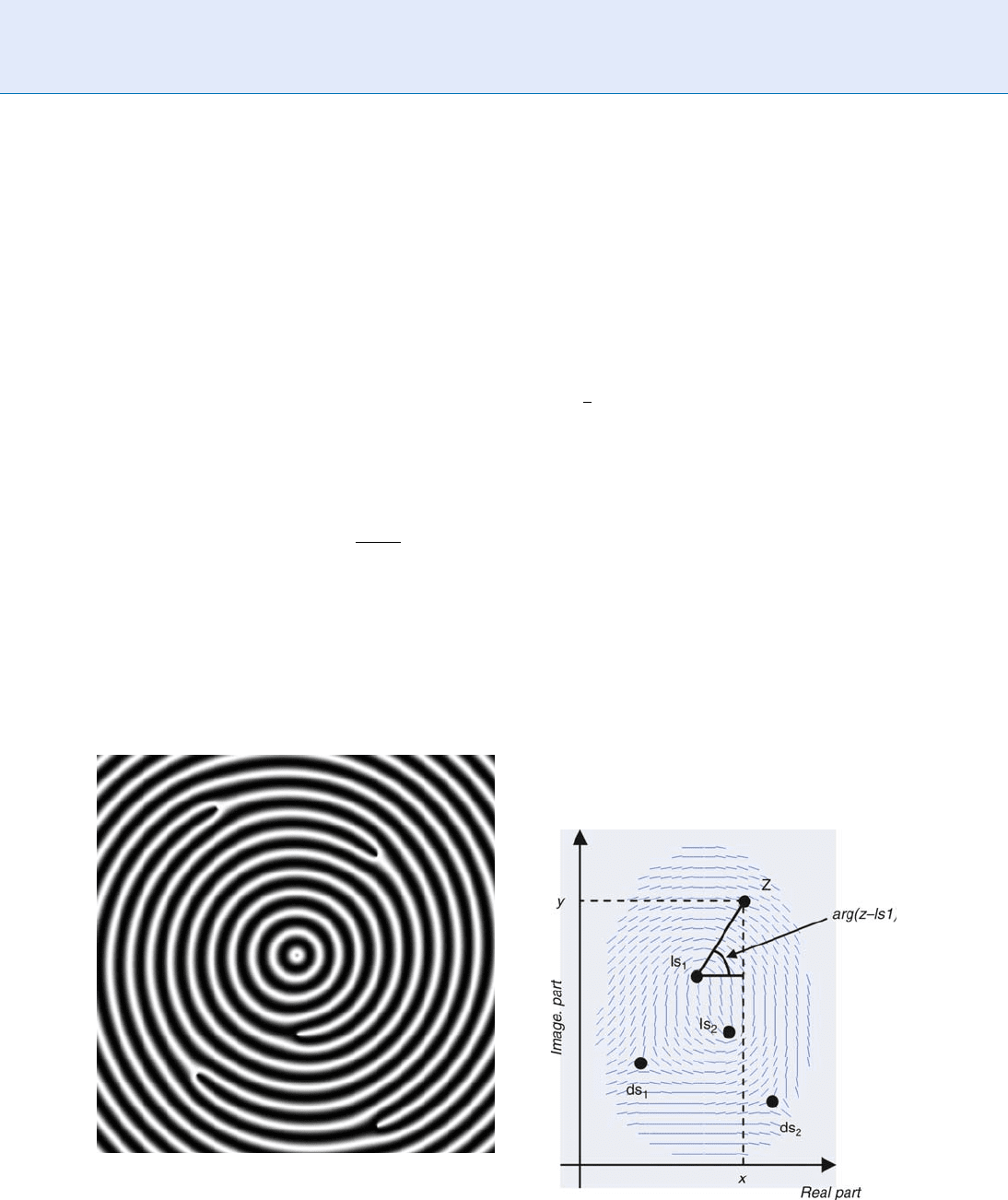
mathematical model of ridge patterns and minutiae
[9]; further details on this technique have been
provided online by Bicz [10] in 2003. According to
this model, a fingerprint can be described by a wave
pattern:
fx; yðÞ¼cos ’ x; yðÞðÞ ð1Þ
where:
’ x; yðÞ¼’
0
x; yðÞþ’
M
x; yðÞ ð2Þ
is a function that defines the phase of the wave struc-
ture as the sum of two parts: ’
0
, which describes the
global ‘‘shape’’ of the ridge lines, and ’
M
, which
describes the minutiae. According to the model intro-
duced by bicz [10], ’
M
can simply generate n minutiae
by adding n spatially-shifted arctangent functions:
’
M
x; yðÞ¼
X
n
i¼1
arctan
y y
i
x x
i
ð3Þ
where (x
i
, y
i
) is the location of minutia i. Figure 3
shows a synthetic pattern generated by using the
above equations.
In 1993, Sherlock and Monro [11] proposed an
orientation model that allows a consistent
▶ orienta-
tion field to be computed from the sole knowledge
of the position of fingerprint
▶ singularities (loops
and deltas). In this model, the image is located in the
complex plane and the local ridge orientation is
the phase of the square root of a complex rational
function whose singularities (poles and zeros) are lo-
cated at the same place as the fingerprint singularities
(loops and deltas). Let ls
i
, i = 1..n
c
and ds
i
, i = 1..n
d
be the coordinates of the loo ps and deltas respecti-
vely. The orientation y at each point z =[x, y]is
calculated as:
y ¼
1
2
X
n
d
i¼1
arg z ds
i
ðÞ
X
n
c
i¼1
arg z ls
i
ðÞ
"#
ð4Þ
where the function arg(c) returns the phase angle of
the complex number c (see Fig. 4).
The Sherlock and Monro model may be exploited
for generating synthetic orientation fields by first ran-
domly choosing a fingerprint class and then randomly
selecting the positions of the singularities, according to
the class-specific constraints (for instance, in a left loop,
the delta must be on the right side of the loop). Figure 5
shows some examples of orientation fields generated
by this model.
However, in nature the ridge-line flow cannot
be completely determined by the singularity ty pe
and position. In 1996, Vizcaya and Gerhardt proposed
a variant of the Sherlock and Monroe mode l that
Fingerprint Sample Synthesis. Figure 3 A simple
synthetic pattern generated by equations (1)–(3),
with ’
0
x; yðÞ¼20 2p
ffiffiffiffiffiffiffiffiffiffiffiffiffiffiffi
x
2
þ y
2
p
and fðx
i
; y
i
Þg ¼
fð0:2; 0:25Þ; ð0:2; 0:37Þ; ð0:0; 0:2Þ; ð0 :25; 0:3Þ;
ð0:2; 0:43Þg.
Fingerprint Sample Synthesis. Figure 4 Sherlock and
Monro model: each element of the orientation field is
considered as a complex number.
516
F
Fingerprint Sample Synthesis
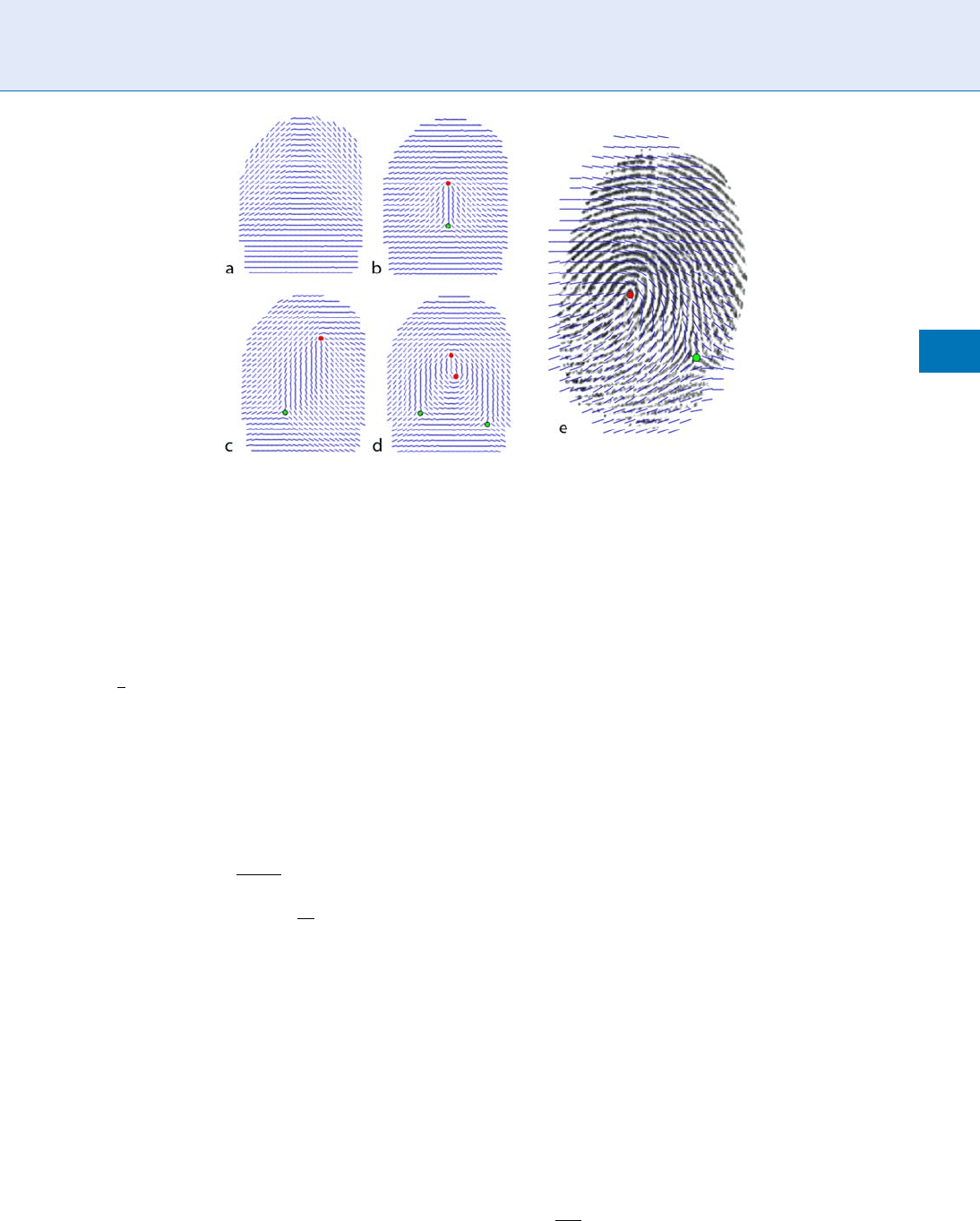
introduces more degrees of freedom to cope with
the orientation variability that may characterize orien-
tation fields with coincident singularities. The orienta-
tion y at each point z is calculated as:
y ¼
1
2
X
n
d
i¼1
g
ds
i
arg z ds
i
ðÞðÞ
X
n
c
i¼1
g
ls
i
arg z ls
i
ðÞðÞ
"#
ð5Þ
where g
k
aðÞ, for k 2 ls
1
; :::; ls
n
c
; ds
1
; :::; ds
n
d
fg
, are
piecewise linear functions capable of locally correcting
the orientation field with respect to the value given by
Sherlock and Monroe model:
g
k
aðÞ¼
g
k
a
i
ðÞþ
a a
i
2p=L
g
k
a
iþ1
ðÞ
g
k
a
i
ðÞðÞð6Þ
for a
i
a a
iþ1
, a
i
¼p þ
2pi
L
.
Each function g
k
aðÞis defined by the set of value s
g
k
a
i
ðÞi ¼ 0:: L 1
jfg
, where each value is the amount
of correction of the orientation field at a given angle
(in a set of L angles uniformly distributed between p
and p). If
g
k
a
i
ðÞ¼a
i
8i 2 0::L 1
fg
(i.e. g
k
aðÞis the
identity function), the model coincides with that of
Sherlock and Monro.
Figure 6a and b show two examples of orientation
fields generated according to the Vizcaya and Gerhardt
model; these images are definitely more realistic than
those in Fig. 5. The superiority of the Vizcaya and
Gerhardt model in approximating existing ridge pat-
terns is also evident from the comparison between
Fig. 6c and d.
In 2000, Cappelli et al. introduced a ridge pattern
generation approach based on the following steps [12]:
1. Orientation field generation
2. Frequency map generation
3. Ridge pattern generation
Step 1 adopts the Vizcaya and Gerhardt model for
generating the orientation field starting from the posi-
tions of loops and deltas; for generating arch type pat-
terns (which do not contain any singularity), a simple
sinusoidal function, whose frequency and amplitude are
tuned to control the arch curvature and aspect, is used.
Step 2 creates a frequency map (see Fingerprint
Feature Extraction) on the basis of some heuristic
criteria inferred by the visual inspection of a large
number of real fingerprints (for instance, in the regions
above the northernmost loop and below the southern-
most delta, the ridge-line frequency is often lower than
in the rest of the fingerprint, see Fig. 7).
Finally step 3, given an orientation field and a frequen-
cy map as input, generates a ridge line pattern by itera-
tively enhancing an initial image (containing one or more
isolated points) through
▶ Gabor filters. The filters are
applied at each pixel (x, y) and adjusted according to
the local ridge orientation f
xy
and frequency v
xy
:
gabor r; s : f
xy
; n
xy
¼ e
rþsðÞ
2
2s
2
cos 2pn
xy
r sin f
xy
þ s cos f
xy
hi
ð7Þ
Fingerprint Sample Synthesis. Figure 5 An example of Arch (a), Tented Arch (b), Right Loop (c) and Whorl
(d) orientation field as generated by the Sherlock and Monro model. In (e), an example of left-loop orientation field
superimposed to a real left-loop fingerprint with coincident singularity positions.
Fingerprint Sample Synthesis
F
517
F
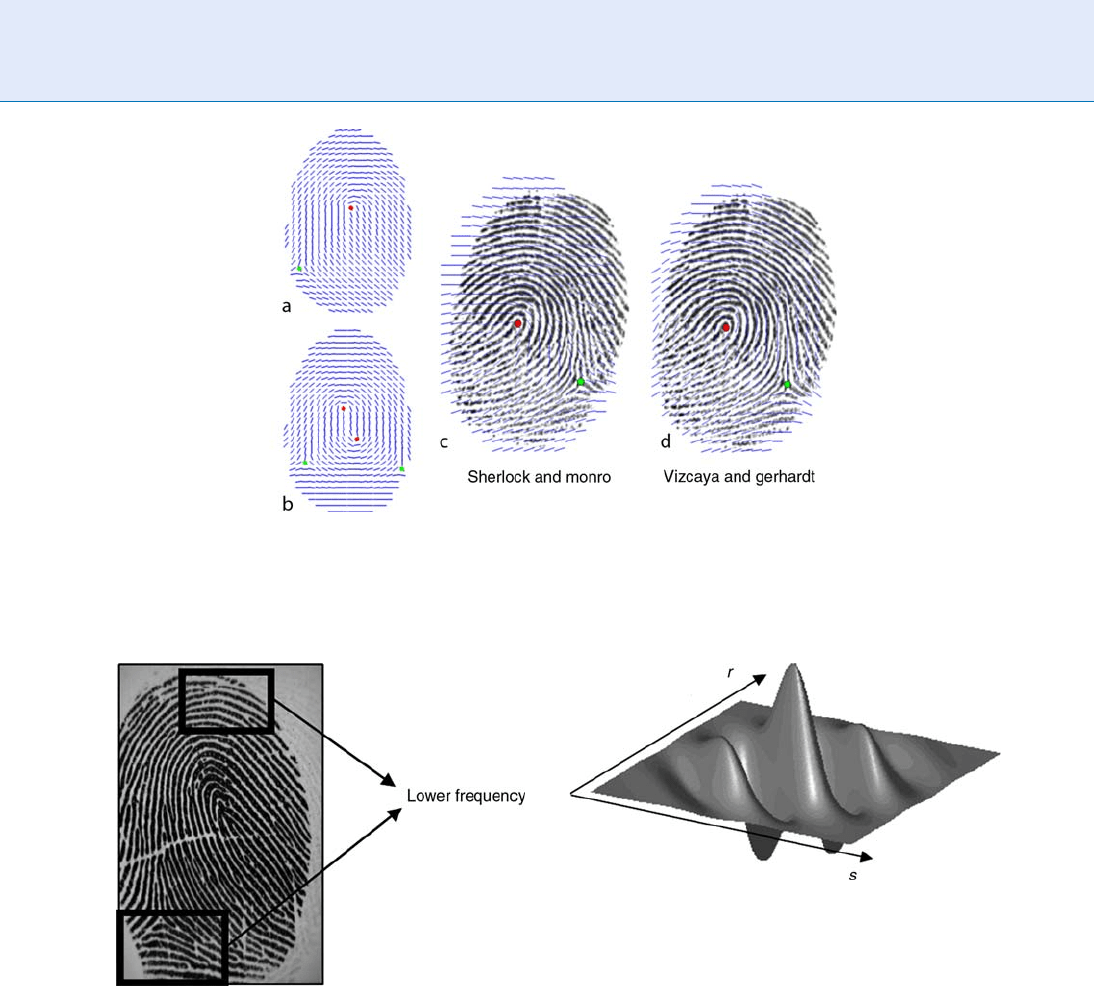
Parameter s, which determines the bandwidth of
the filter, is set according to the frequency, so that the
filter does not contain more than three effective peaks
(see Fig. 8).
While one could reasonably expect that iteratively
applying ‘‘striped’’ filters to random images would
simply produce striped images, very realistic minutiae
are generated at random positions. Based on their
experiments, in [12] the authors argue that minutiae
primarily originate from the ridge-line disparity
produced by local convergence/divergence of the
orientation field and by frequency changes. In Fig. 9,
examples of the iterative ridge-line generation process
are shown; the authors experimentally found that
increasing the number of initial points determines
a more irregular ridge pattern richer of minutiae: this is
not surprising, since expanding distinct image regions
causes interference where regions merge, thus favoring
the creation of minutiae (see Fig. 10).
Generation of Synthetic Fingerprint
Impressions
Several factors contribute in making the impressions
of a real finger substantially different when captured
Fingerprint Sample Synthesis. Figure 7 An example of a
right-loop fingerprint where the ridge-line frequency is
lower in the regions above the loop and below the delta.
Fingerprint Sample Synthesis. Figure 6 An example of Right Loop (a) and Whorl (b) orientation fields, as generated
by the Vizcaya and Gerhardt model. In (c) and (d) the orientation fields produced by the two models, for a given
fingerprint, are compared.
Fingerprint Sample Synthesis. Figure 8 An example of
Gabor filter used in step 3: note that the bandwidth is
adjusted so that the filter does not contain more than
three peaks.
518
F
Fingerprint Sample Synthesis
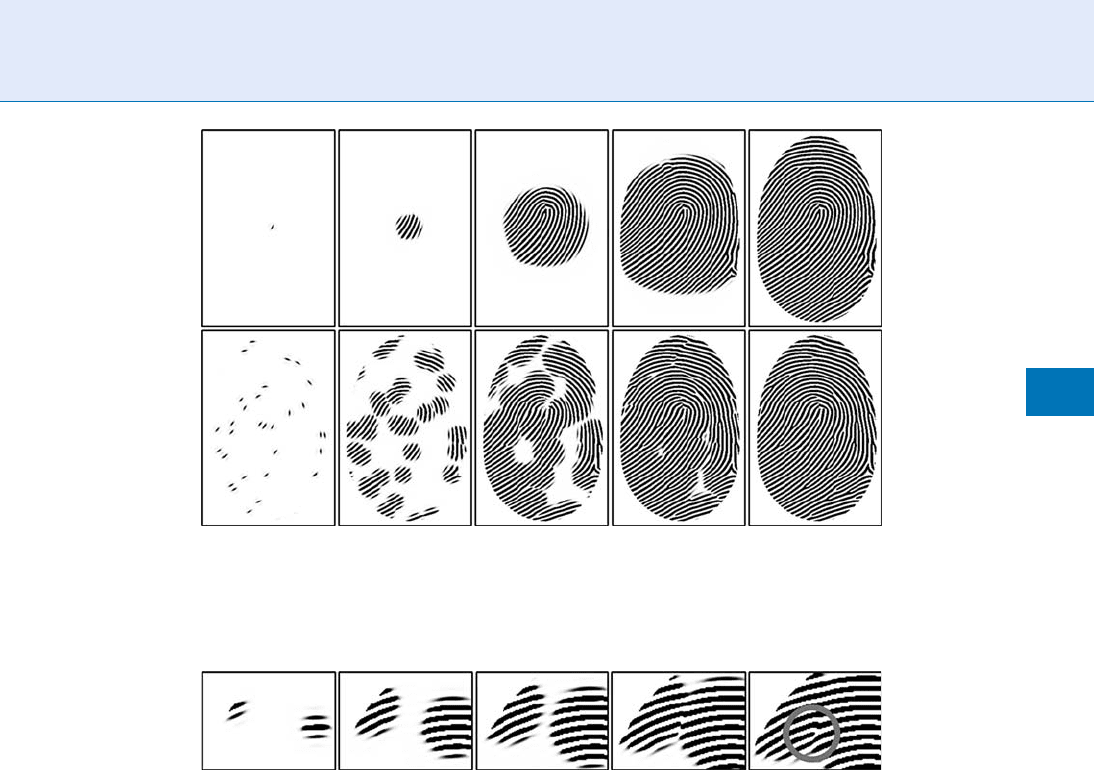
by an on-line acquisition sensor (see ▶ Fingerprint
Device):
1. Displacement in x and y direction and rotation
2. Different touching areas
3. Non-linear distortions produced by non-orthogonal
pressure of the finger against the sensor
4. Variations in the ridge-line thickness given by pres-
sure intensity or by skin dampness
5. Small cuts or abrasions on the fingertip
6. Background noise and other random noise
In 2002, Cappelli et al. proposed an evolution of the
approach introduced in [13], which is able to simulate
most of the above factors, thus generating very realistic
fingerprint impressions. Starting from a synthetic
ridge-line pattern, the main steps involved in the sim-
ulation of a fingerprint impression are: (1) Variation of
the ridge thickness; (2) Skin distortion; (3) Noising
and global translation/rotation; (4) Background
generation. The subsections that follow briefly
describe the various steps, as they were proposed by
Cappelli [14].
Variation of the Ridge Thickness
Skin dampness and finger pressure against the sensor
platen have similar effects on the acquired images:
when the skin is dry or the pressure is low, ridges
appear thinner, whereas, when the skin is wet or the
pressure is high, ridges appear thicker (see Fig. 11 ).
Morphological operators (see Image Pr epr oc essing)
are applied to the ridge line pattern, to simulate different
degrees of dampness/pressur e. In particular, the erosion
operator is applied to simulate low pressure or dry
skin, while the dilation operator is adopted to simulate
high pressure or wet skin (see Fig. 12).
Skin Distortion
One of the main aspects that distinguish the different
impressions of the same finger is the presence of non-
linear distortions, mainly due to skin deformations
Fingerprint Sample Synthesis. Figure 9 Some intermediate steps of a fingerprint-generation process starting from a
single central point (top) and from a number of randomly located points (bottom). Usually, increasing the number of
initial points determines a more irregular ridge pattern richer of minutiae.
Fingerprint Sample Synthesis. Figure 10 Genesis of a minutia point during the merging of the two regions
originated by two different initial points.
Fingerprint Sample Synthesis
F
519
F
